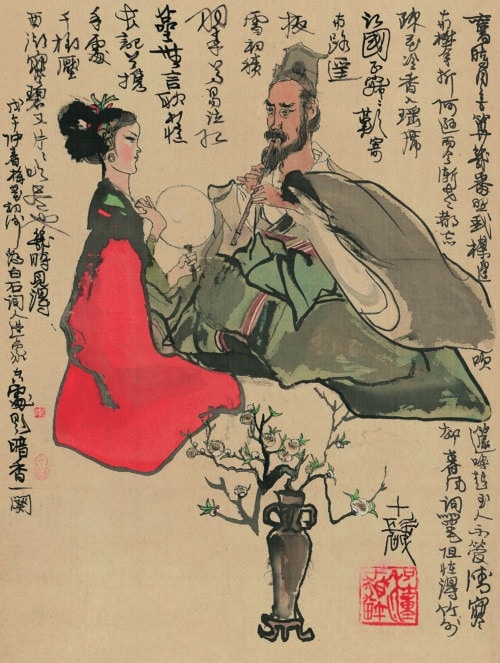Paintings by Cheng Shifa

We are still in a festive mood due to the fifth anniversary of the establishment of the China Cultural Center in Brussels. Additionally, with the Mid-Autumn Festival drawing near, we want to keep posting content to brighten your days. Today, we celebrate with paintings from CHENG Shifa.
A few months ago, Cheng Shifa’s art was introduced for the first time through the “Cheng Shifa Art Exhibition”. As a Chinese painting master active in the twentieth century, he became known for combining Chinese techniques with Western methods. The eight paintings below further demonstrate his skill and virtuosity.
This painting depicts a scene portrayed in the poem Hidden Fragrance, containing well-known lyrics on plum flowers. It was written by a poet from Southern Song dynasty named Jiang Kui, also known as Jiang Yaozhang or Jiang Baishi. He felt helpless and longed for his lover when writing the lyrics, “The moon has an old color. / How many times has it shone on me / while I play a flute by the plum flowers? / I recall a woman of jade / even though it was chilly / breaking off a plum twig at departure.”
Jiang was talented in multiple areas, including poetry, prose, calligraphy and music. His lyrics are perfect in rhymes and rhythm, and he would compose music for his own poems. He was known as an art genius like Su Shi. Jiang’s lyrics are remarkable for depicting desolate and bitter scenes.
In the painting, an old man is playing his flute with a frown on his face, sitting across a lady in red. Both of them are looking at each other. Next to them is a twig of plum flower in a vase, hinting at a hidden fragrance. Cheng Shifa managed to recreate Jiang’s lyrics in this painting: wild but exquisite, reserved yet free. It lingers on viewers’ minds, just like Jiang’s lyrics.
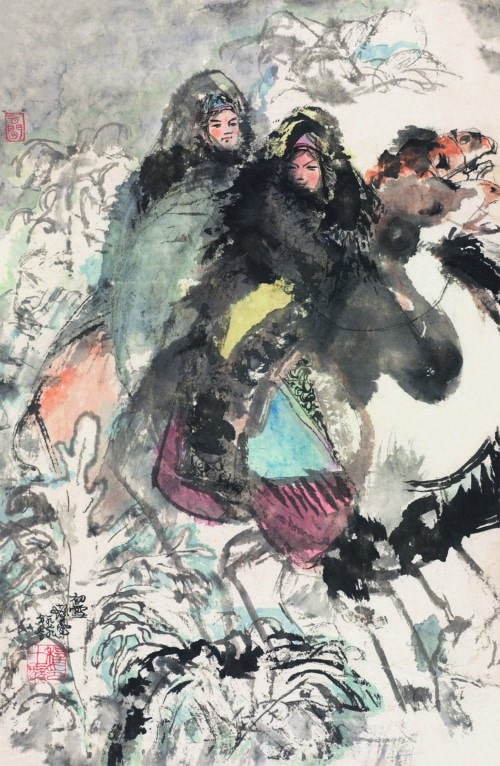
Cheng Shifa, First Snow, 70 x 46 cm, 1979
This picture depicts two maidens riding a camel, beside whom the plants are outlined in ink, leaving the white space to show a view of the North where everything is blanketed by snow. In the center of this painting, slightly thicker ink is applied to highlight the figures and camel. The girls’ faces and the camel’s head are delineated in detail, while the rest of the painting is presented with great freehand brushwork in harmonized ink and color. The strokes are crude, yet vividly reproduce the fluffy and thick cloaks, showcasing the painter’s superior mastery of brush and ink. The dark and thick cloaks along with the white background contrast with the girls’ ruddy faces, delivering a favorably radiant and enchanting look, while their youth in turn endows the whole painting with a kind of inherent vitality. The picture’s gist is accentuated by contrast, one of the painting techniques Cheng Shifa preferred. He once said, “I like to use contrast…for instance, between exquisite and crude, strong and weak, and this technique is quite often seen in China’s folk art and traditional opera. It can impress the audience strongly, as it often highlights lines and colors and optimizes the composition.” Representing the style in Cheng’s middle-to-late period, this picture is marked by his skillful use of ink and colors and bold composition, with an emphasis on lines and strokes, delivering the vivid charm of the figures accomplished by contrast and exaggeration.
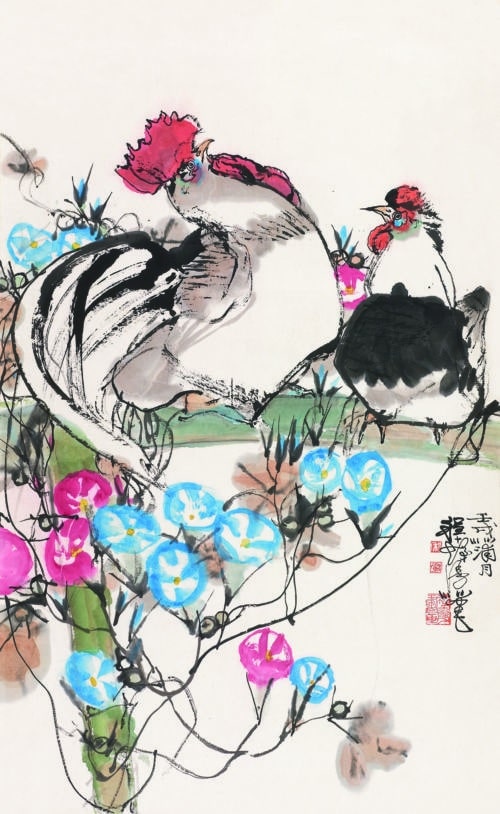
Cheng Shifa, Morning Glory and Roosters, 96 x 59 cm, 1982
In Morning Glory and Roosters, Cheng Shifa outlined two vigorous roosters with flexible brushstrokes that turn strong or gentle wherever needed, making the two roosters come alive. Around the roosters are boldly-lined thin vines twining around green stems, and morning glories randomly dyed in red and blue. The fresh and bright colors bring out the best of the ink-painted roosters. Featuring a sense of freshness and profoundness, this artwork best exemplifies Cheng’s pursuit of a well-balanced combination of “lifelikeness” and “charm” in bird-and-flower paintings.
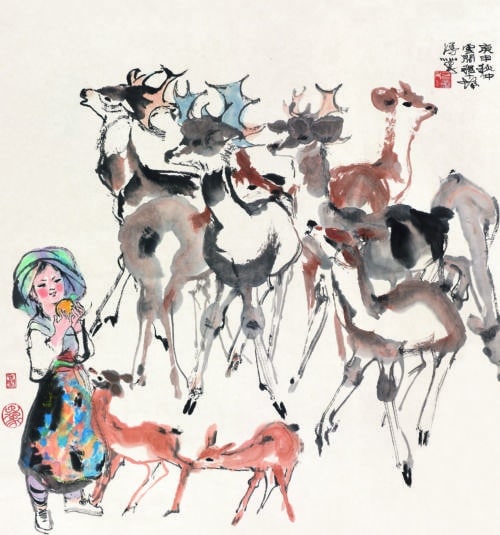
Cheng Shifa, Young Girl and Deer, 96 x 90 cm, 1980
This painting portrays a young ethnic minority girl with a herd of deer. In the bottom left corner of the square painting is a young girl with round face and healthily rosy cheeks, holding an orange and dressed plainly. Beside her are two fawns wanting to cuddle and behind her a herd of deer is gathering. It is a serene and sweet scene where a human lives harmoniously with animals. The deer are depicted in the central position, as they are the main subject of the painting. Each of them is outlined with wide brushstrokes and colored casually in light ink, abstract yet distinct from each other: some are taller, some shorter, some raising their heads and some looking down. Only their antlers are outlined in detail with fine strokes, perfectly highlighting their vibrancy and strength. In sharp contrast to the deer, the young girl, gently smiling, is depicted in further detail. Well balanced between complexity and simplicity, the painting vividly shows the bright and pure disposition of the young girl, as well as the vigor of the deer. This simplistic style, according to Cheng Shifa, depends on the principle that “however weird as it may be realistically, the objects must be vividly painted”, which he applied to drawing the deer. A young girl along with deer, as a symbol of beauty, comfort and kindness, is one of Cheng’s favorite subjects, and reflects his pursuit of an aesthetic experience of daily life.
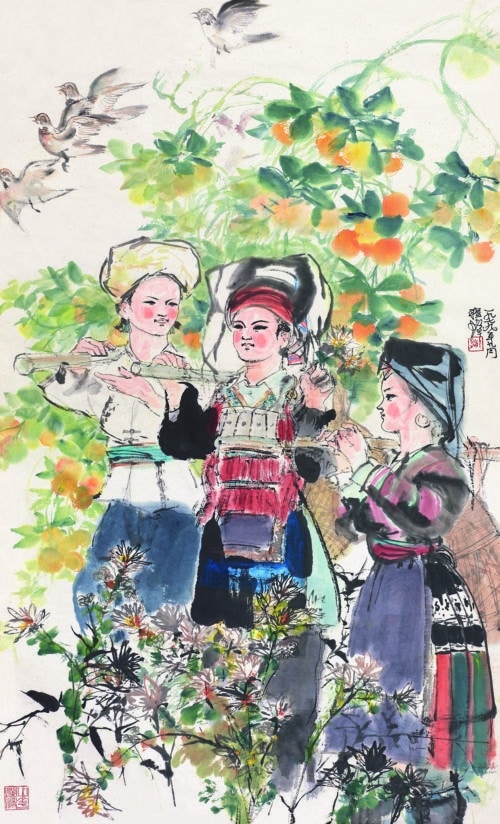
Cheng Shifa, When Oranges Turn Yellow and Tangerines Look Green, 134.5 x 81.5 cm, 1979
This piece of artwork depicts three ethnic minority teenagers looking cheerful in a vibrant autumn scene. Set on a typical autumn day, the painting presents three teenage boys with farm tools on their shoulders, chatting and strolling, against thick boughs laden with golden oranges and ripening tangerines. Their ruddy cheeks suggest good health and a cheerful mood, revealing the honesty and simplicity in their character. In general, the painting highlights a bright, upbeat spirit by presenting the joys of autumn harvest. Cheng sets the three teenagers at the center of the composition, using thick and thin lines with angular or round corners, texture strokes in ink and shadings in various colors to achieve a naturalistic effect on their looks. Their ethnic minority costumes are painted mainly in unobtrusive colors like black, white and blue-gray with a slight tinge of red, stressing their youthfulness and enthusiasm, and adding a sense of liveliness to the painting.
The painting is further enriched by several clusters of wild chrysanthemums in the foreground. Though outlined in slim ink strokes and painted in light colors, they display robust vitality and a love for life. In contrast, the backdrop of the painting, featuring overlapping boughs laden with yellow oranges and green tangerines, looks arresting with various bright colors, which complement the cool tones in the foreground to make a perfect equilibrium in color without undue flamboyance. Apart from portraying the figures and plants, Cheng added a handful of birds fluttering in the blank space above the orange trees, a practice both following the common composition method in traditional Chinese paintings and naturally rendering the painting animated with lovely, winged creatures. Overall, When Oranges Turn Yellow and Tangerines Look Green demonstrates Cheng’s superb composition skills and brilliant, artful command of lines and colors.
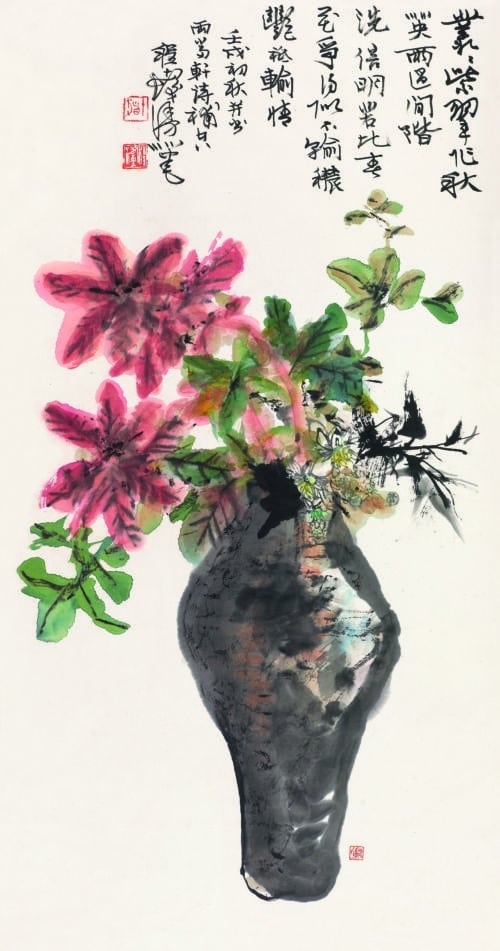
Cheng Shifa, Vase of Flowers, 95.5 x 60.5 cm, 1982
This painting depicts a bouquet of blooming flowers in a vase. Painted with the “mogu” technique, the petals are rendered by layered color washes, while the flower veins are drawn with ink, which adds the finishing touch to the flowers. The fancy flowers in various shades of red are accompanied by green leaves and a few small yellow flowers, all of which overlap with each other in various heights, creating a sense of exuberance.
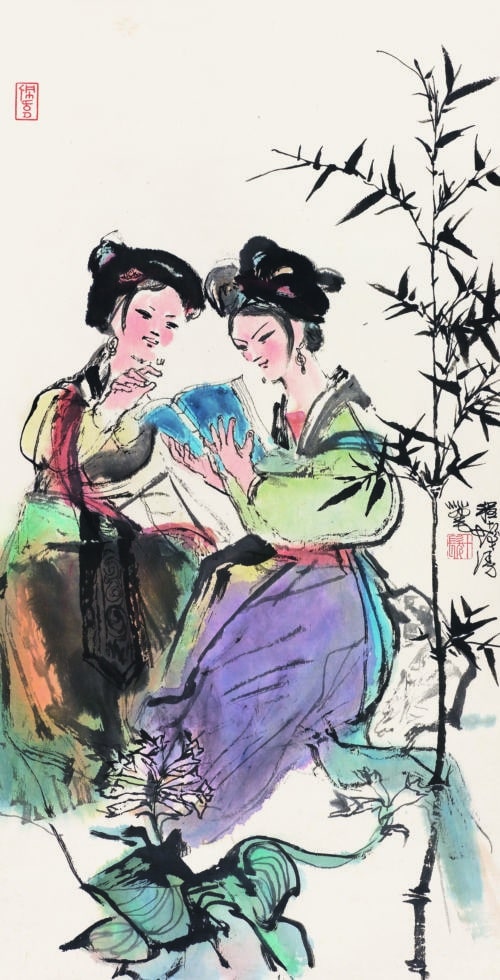
Cheng Shifa, Ladies Reading One Book, 93.5 x 47.5 cm, date unknown
Ladies Reading One Book depicts the scene of two ladies in traditional costumes reading one book together. The two ladies, one wearing a violet dress and the other in light yellow, are sitting on a stone, sharing a book and exchanging comments. In the presence of slim bamboo and flowers, the painting conveys a sense of elegance and delicacy with vigor embodied in the rosy-cheeked young ladies. The figures are highlighted by the clear background. Shaped with crude contour lines and detailed with diverse strokes delivered by pressing, lifting, rotating and turning the brush nimbly, the figures are presented in a vivid and appealing way without rigid depiction of authentic details. Shading is executed with washes and moist ink, creating a natural and smooth transition between warm and cool colors. The overlapping and blending of different colors produces a free and casual beauty. Ink and colors, applied in varying thickness to different parts of the figures, combine well with the lines to vividly present the ladies’ postures. Cheng proficiently used controlled and flowing strokes to depict the ladies’ contours and manners, showing their innocent beauty and graceful temperament. Interspersed in a well-balanced manner by a slim bamboo and a bunch of flowers, the painting oozes a glamorous sense of elegance and delicacy.
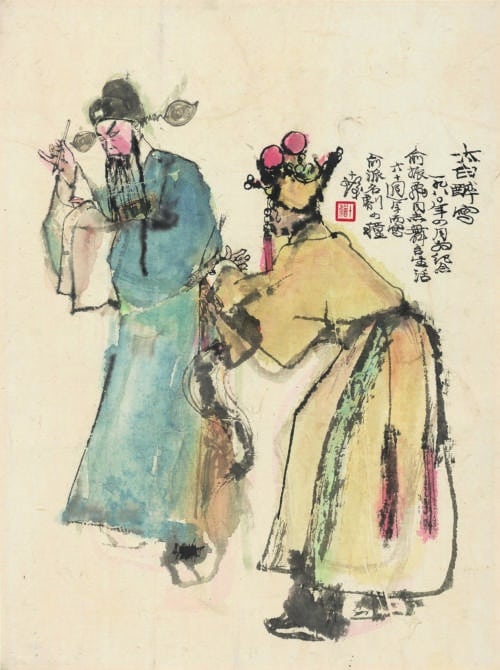
Cheng Shifa, Drunk Writer Taibai, 42 x 31.5 cm, 1980
In 1980, the painting Drunk Writer Taibai was created by Cheng Shifa as a tribute to Mr. Yu Zhenfei’s 60th anniversary of being an actor of Chinese Kunqu Opera. It was included in Cheng’s collection Four Great Kunqu Operas of Yu School. Despite its small size, the painting is composed in a concise and vivid manner to enliven the characters. Simple lines are used to sketch the contours and specific shading is applied to each character’s costume to distinguish their identities in every single scene. The story of Drunk Writer Taibai, as told in Yu’s performance, is about the Tang dynasty poet Li Bai. He was once, while drunk, called into the imperial garden by Emperor Xuanzong and his beloved consort Yang Guifei to write a new poem for the most fashionable tune. The painting is a perfect record of the actor’s emotion, movement and outstanding technique. On top of that, the artistic insight and sense of Cheng Shifa as a keen theatergoer adds to his true feelings behind the ink and colors.

